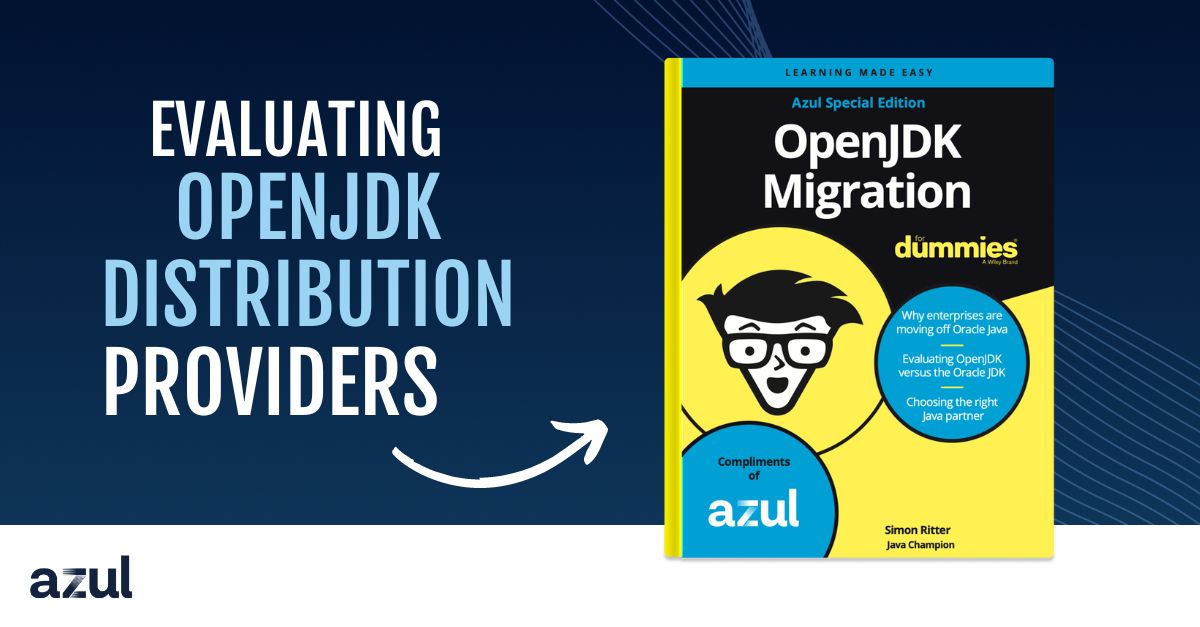What is Open Source Technology?
Open-source technology is software that is developed by a community of users, who each can play an active role in creating new code, adapting existing code, or replicating someone else’s code. Open-source technology allows users to develop the technology together, working to accelerate the growth of opportunities and the introduction of new capabilities to the technology. OpenJDK is an open-source community for Java users.
What is OpenJDK?
OpenJDK allows Java users to incorporate services, shortcuts and programs into their application architectures, without having to develop the code themselves. Users can pull from libraries and databases to customize code for their individual uses. Azul contributes our own expertise to OpenJDK, using our 20-year heritage in Java leadership to do so. Azul Platform Core has the world’s best supported builds of OpenJDK and costs 70% less than Oracle’s builds. Built by Java leaders, Azul Platform Core provides 100% open source, fully tested and certified, Java SE standards-compliant, well-curated builds of OpenJDK.
How do enterprises use open-source technology?
In open-source technology, the community of users can both create new code and adapt the codes others have contributed. Additionally, because all the content produced is publicly available, community members can also use code created by others.
An open-source community is made up of developers. These specialists support open-source builds by providing access to the various codes they develop. For example, in OpenJDK, people create codes to advance the capabilities of Java programs. This may include developing codes that construct new services or that more efficiently perform a function. Developers can also adapt the code created by other users. Some changes may include repairing vulnerabilities they locate in codes, rewriting codes for new uses or exploring combinations of different service features.
Community members can also replicate codes from the software for their own purposes. This means that performance optimizations or efficiency enhancements created by one person can be uploaded for the entire community to use. The collaborative element of open-source technology allows the community to grow the technology together.
What are the benefits of open-source technology?
Most good ideas don’t start and end with the same person. Think of the car you drive to work every day. Long before the car was created, someone came up with the idea of a wheel, which inspired a series of ideas. After many designs, the world was brought horse drawn carriages, bikes and finally the car. And the innovation likely won’t end here. People are inspired by others and can then bring their own expertise to drive innovation. The same principle applies to open-source technology; people inspire and drive technology innovation together, not alone.
New developments also occur when people can specialize. Companies can share technology developments rather than having to innovate independently. When a company wants to introduce a new service to an application, they can pull from an existing code, rather than having their team of developers devise the solution themselves. This speeds the time of development, allowing companies to focus on creating new opportunities, rather than having to develop solutions that already exist.
What risks are involved with open-source technology?
Security threats have been the main concern plaguing open-source technology. The benefit of open-source technology is collaboration, but this feature can also be maliciously exploited. Everyone has access to the same codes, so attackers can analyze available codes and identify opportunities for exploitation. Attackers hope to locate vulnerabilities and the consequences can be detrimental when the code has already been widely adopted code. However, this doesn’t occur often because specialists in the community can also locate vulnerabilities. The vulnerability can be detected and repaired by specialists before the code is adopted into company infrastructures.
Another security concern in open-source technology is that vulnerabilities can be intentionally uploaded by attackers, in hopes that the code is adopted by others. This means that developers should adopt code with caution. Many developers will review code in the open-source community, reducing the frequency of these incidents.
These security concerns have always been deemed a critical issue, but the severity of this threat was made apparent during the Log4Shell incident. Failure to detect and patch known vulnerabilities in their Java application estates can expose organizations to significant impact and cost, including financial penalties running into the hundreds of millions of dollars, compromise of customer data, lower market capitalization, and turnover in executive staff.
How does Azul optimize open-source technology?
Azul is leading the way for solutions that address vulnerability concerns in open-source technology. Detecting vulnerabilities in production is more critical than ever for enterprises. Azul Vulnerability Detection is a feature of Azul Intelligence Cloud that allows users to continuously monitor their Java applications to detect known vulnerabilities in production. Azul Vulnerability Detection runs in the JVM. Azul Vulnerability Detection contains a function called the Component Knowledge Base, which identifies open-source components running in customer production environments and automatically checks them against a knowledge base of common vulnerabilities. When there is a match, Azul automatically sends an alert so the customer can take action.
Azul Vulnerability detection checks all of an enterprise’s Java-based software for vulnerabilities – whether they built it, bought it, or are introducing a regression with a recent change. The product also retains detection history, helping enterprises focus forensic efforts to determine if vulnerable code was actually exploited prior to it being known as vulnerable. This allows the Java developer community to enjoy the benefits of open-source technology, while forgoing the headaches brought on by security concerns.





